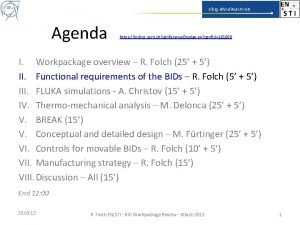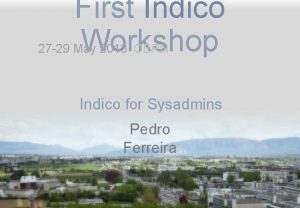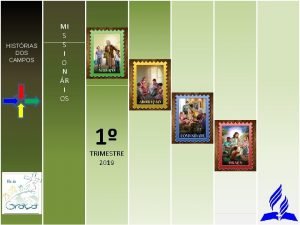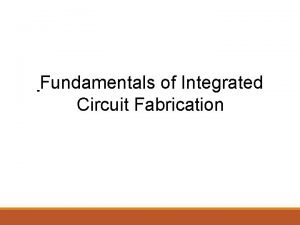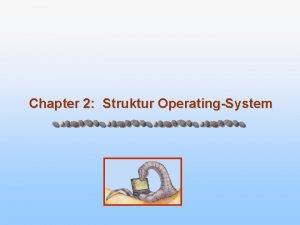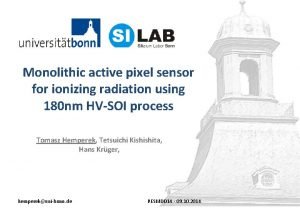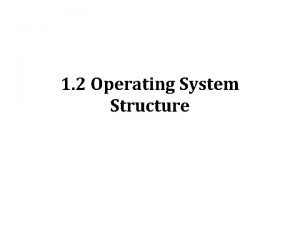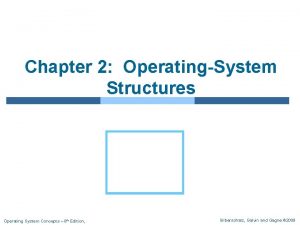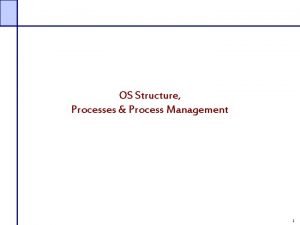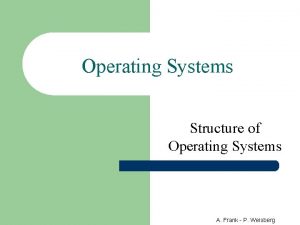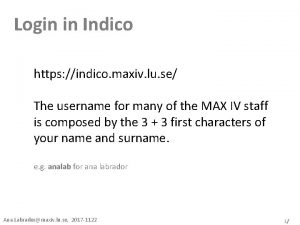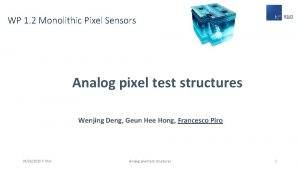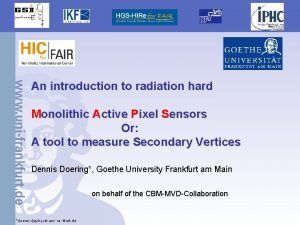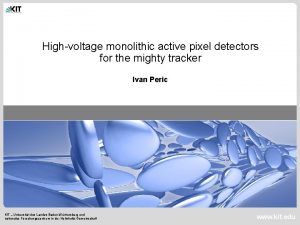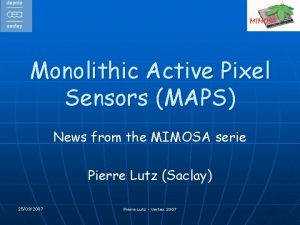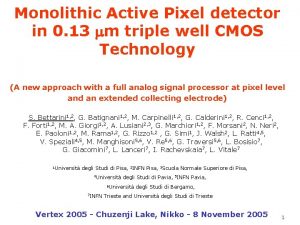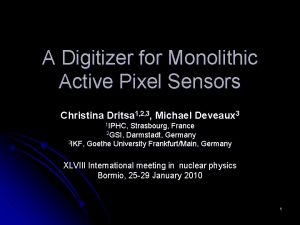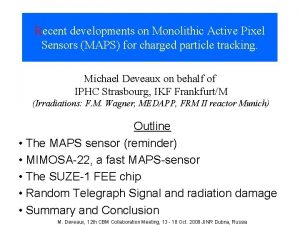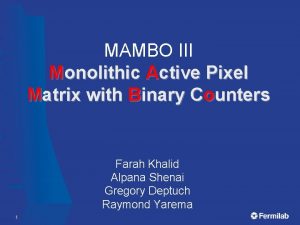https indico cern chevent640107 Depleted Monolithic Active Pixel


















- Slides: 18

https: //indico. cern. ch/event/640107/ Depleted Monolithic Active Pixel Sensors for ATLAS Upgrade Dima Maneuski et. al.

Presentation plan Presentation Plan • Motivation for the ATLAS ITk • Performance requirements • CMOS options • CMOS technologies • Current CMOS developments • AMS • LFoundry • TJ • Conclusions 19 July 2017 Dima Maneuski, Advances in rad-hard MAPS 2016, Birmingham 1

Motivation ATLAS Inner Tracker (ITk) for HL-LHC: ~200 m 2 silicon • Radiation tolerant to expected fluencies • Can operate with 25 ns bunch crossing and increased pile up • Increased granularity • Reduced material budget • Low cost modules with high production throughput Potential alternative to planar silicon sensors is commercial CMOS • Performance: • Cost: • Several vendors • Radiation hardness • High volume • Thinner charge collection layer • Large wafers (8 -12 inch) • High S/N Time scale: expected switch on time around 2024 19 July 2017 Dima Maneuski, Advances in rad-hard MAPS 2016, Birmingham 2

Performance requirements • Converging on the CMOS sensor for the ITk Pixel Outer Layer 4 • 1. 5 x 1015 neq/cm 2 and 80 Mrad TID Credit: A. Gaudiello et al. , IWORID’ 17 • Hitrates up to 2 MHz/mm 2 (peak) • Timing: < 25 ns • Efficiency: > 95% after irradiations • Pixel size: < 50 um • Chip size like ATLAS-1 Pixel FE chip • CMOS to be integrated into quad and double chip modules like Hybrid Pixel Module • Interface compatible with Hybrid Quad Module towards powering and readout 19 July 2017 Dima Maneuski, Advances in rad-hard MAPS 2016, Birmingham 3

CMOS options Capacitive coupling Capacitively coupled pixel detector (CCPD) Diode + Preamp CMOS pixel + FE chip • Thinner devices • Flip-chip simplification • Collecting diode + readout + processing electronics on wafer • No flip-chip • Thin devices • Increased granularity • Lower analog power (for small pixel capacitance designs) Front End chip Monolithic Active Pixel Sensor (MAPS) Diode + Preamp + Processing electronics 19 July 2017 • Dima Maneuski, Advances in rad-hard MAPS 2016, Birmingham 4

CMOS technologies Fabrication foundries under consideration • AMS (180 and 350 nm) • ESPROS (150 nm, High Resistivity option) • Global Foundry (130 nm, High Resistivity option) • LFoundry (150 nm, High Resistivity option) • XFAB (180 nm, SOI option) • ST Microelectronics (160 nm) • Toshiba (130 nm) • Tower Jazz (180 nm, High Resistivity Epi option) • IBM (130 nm) • ON Semiconductor (180 nm) 19 July 2017 Dima Maneuski, Advances in rad-hard MAPS 2016, Birmingham 5

Current developments CCPD* Monolithic + periphery Monolithic structures Vendor nd 2 n io t ra e n ge Sensor name Technology node Size (mm 2) # pixels Pixel size (um 2) AMS H 18_CCPD 180 nm 2. 2 x 4. 4 Various 25 x 25, 33 x 125, 25 x 350 LFoundry LF_CCPD 150 nm 5 x 5 32 x 140 33 x 125 AMS H 35_DEMO 350 nm 18. 5 x 24. 4 16 x 300, 23 x 300 50 x 250 LFoundry LF_CPIX 150 nm 9. 5 x 10 34 x 168 50 x 250 Tower. Jazz TJ investigator 180 nm 5 x 5. 7 134 matrices LFoundry Monopix 150 nm 9. 5 x 10 36 x 142 50 x 250 Tower. Jazz TJ_MALTA 180 nm 18 x 18 512 x 512 36 x 36 Tower. Jazz TJ_Monopix 180 nm 10 x 18 256 x 512 36 x 40 AMS ATLASPix / Mu. Pix 8 180 nm 21. 3 x 22. 6 2 matrices 56 x 56 LFoundry ATLASPix 150 nm 10 x 10 5 matrices 40 x 100, 40 x 60, 40 x 250 20 x 20 -> 50 x 50 *Capacitively coupled pixel detector (CCPD) 19 July 2017 Dima Maneuski, Advances in rad-hard MAPS 2016, Birmingham 6

AMS H 18 CCPD (CCPDv 4) • Standard 10 Ω·cm substrate • Irradiated to 1. 3 e 14 and 5 e 15 neq / cm 2 • Developed gluing process • Pion test beams • Hit efficiency 97. 6% (irradiated) to 99. 7% (unirradiated) • Efficiency performance comparable to planar Silicon Credit: M. Benoit et. al. ar. Xiv: 1611. 02669 19 July 2017 Dima Maneuski, Advances in rad-hard MAPS 2016, Birmingham 7

AMS H 35 Demo • Monolithic sensor demonstrator • Different pixel flavours • Different substrate resistivities • Efficiency before irradiations demonstrated 99. 1% • 99% of charge collected within 2 BC Credit: S. Terzo et al. , JINST 12 (2017) no. 06, C 06009 Credit: A. Gaudiello et al. , IWORID’ 17 19 July 2017 Dima Maneuski, Advances in rad-hard MAPS 2016, Birmingham 8

What’s next in AMS process? AMS H 18 ATLASPIX • Drop-in solution for outer layers • Fully integrated • Large fill factor monolithic design • 180 nm AMS HV CMOS • Default resistivity is 20 Ω cm • Triple well process Roadmap: • p. ATLASpix-1 a/b/c prototype, February 2017 • p. ATLASpix-2 prototype, August 2017 • • Periphery blocks p. ATLASpix-3 prototype, February 2018 Periphery + full matrix ATLASpix final design, 2018 19 July 2017 Dima Maneuski, Advances in rad-hard MAPS 2016, Birmingham 9

LFoundry LF_CCPD • L-Foundry 150 nm process • Resistivity of wafer: >2000 Ω·cm • Chip size 5 x 5 mm • 33 x 125 um pixel size • 24 x 114 pixels, 3 pixel flavours • R/O coupled to FE-I 4 and stand alone • Subpixel decoding demonstrated • Irradiated to 50 Mrad TID • Irradiated to 1. 2 e 15 neq / cm 2 Credit: T. Hirono et. al. 1. 2 e 15 neq / cm 2 Credit: D. Maneuski et. al. 19 July 2017 Dima Maneuski, Advances in rad-hard MAPS 2016, Birmingham 10

LFoundry CPIX (LF_CPIX) • L-Foundry 150 nm process • Resistivity of wafer: 2000 Ω·cm • High fill factor • Chip size 9. 5 x 10 mm • Pixel size 50 x 250 um • 36 x 158 pixels, three pixel flavours • Process to thin down to 100 um developed • Better leakage current • More radiation tolerant Credit: L. Vigani et. al. Credit: T. Hirono et. al. 19 July 2017 Dima Maneuski, Advances in rad-hard MAPS 2016, Birmingham 11

LFoundry Monopix • Monolithic: amplifier, discriminator, To. T, readout • Designed to satisfy noise, time, speed requirements • Resistivity of wafer: >2000 Ω·cm • Pixel 50 x 250 um • 129 x 36 pixels @ 40 MHz clock • Backside processing Credit: T. Wang et. al. 2017 JINST 12 C 01039 19 July 2017 Credit: I. Caicedo et. al. Dima Maneuski, Advances in rad-hard MAPS 2016, Birmingham 12

What’s next in LF process? LFoundry ATLASPix • Technology LFA 15 (150 nm) • Different pixel sizes • Different matrices (1 CCPD and 5 monolithic) and test structures • Resistivities: 100 Ω·cm, 500 -1 k Ω·cm, 1. 9 k Ω·cm and 3. 8 k Ω·cm • 4 -well HVCMOS process • Different Readout concepts 19 July 2017 Dima Maneuski, Advances in rad-hard MAPS 2016, Birmingham 13

Tower. Jazz Investigator Sr 90 MIP • Designed as part of the ALPIDE development for the ALICE ITS upgrade • Emphasis on small fill-factor and low capacitance • Epitaxial layer on high resistivity substrate • Many variations of pixel size and layout Signal Amplitude [e] Tower. Jazz Investigator Credit: C. Riegel et. al. Time [ns] Credit: D. Maneuski et. al. 19 July 2017 Dima Maneuski, Advances in rad-hard MAPS 2016, Birmingham 14

What’s next in TJ process? TJ_Malta TJ_Mono. Pix • Full matrix 512 pixels • Full matrix 512 x 256 pixels • Active area 18 x 18 mm 2 • Active area 18 x 10 mm 2 • Hit memory in active matrix (2 flip-flop per pixel) • All hits are Asynchronously transmitted over high- speed • Synchronous column drain bus to EOC logic architecture • No clock distribution over active matrix to minimize power and digital-analog cross-talk 19 July 2017 • Hit address asserted to bus with 40 MHz token • 6 bit TOT coding at end of column Dima Maneuski, Advances in rad-hard MAPS 2016, Birmingham 15

Conclusions • Demonstration continues to show CMOS technology could be a viable candidate for the ATLAS ITk upgrade • CMOS devices from different foundries generally shown to operate after the expected radiation damage at the mid/outer layer of the ATLAS ITk • Many performance issues found in first iterations of designs were addressed in the full scale demonstrators • General consensus to work on Monolithic CMOS sensor for the outer layer of the ITk for the TDR 2017 • Aim at the drop-in module solution • CMOS developments have huge potential in fields outside particle physics 19 July 2017 Dima Maneuski, Advances in rad-hard MAPS 2016, Birmingham 16

Thank you for your attention Any 19 July 2017 Dima Maneuski, Advances in rad-hard MAPS 2016, Birmingham s? n o i t ques 17
 Indico cern
Indico cern Indico cern
Indico cern Indico cern
Indico cern Indico cern
Indico cern Indico cern
Indico cern Indico cern
Indico cern Indico cern
Indico cern Divisão sul africana oceano indico
Divisão sul africana oceano indico Indico desy
Indico desy Monolithic ic fabrication
Monolithic ic fabrication Monolithic operating system
Monolithic operating system Ulsi (ultra large scale integration)
Ulsi (ultra large scale integration) Monolithic trench drains
Monolithic trench drains Monolithic sensor
Monolithic sensor Cooperative multitasking
Cooperative multitasking Operating system structure
Operating system structure Monolithic operating system
Monolithic operating system Layered kernel
Layered kernel Monolithic antonym
Monolithic antonym

